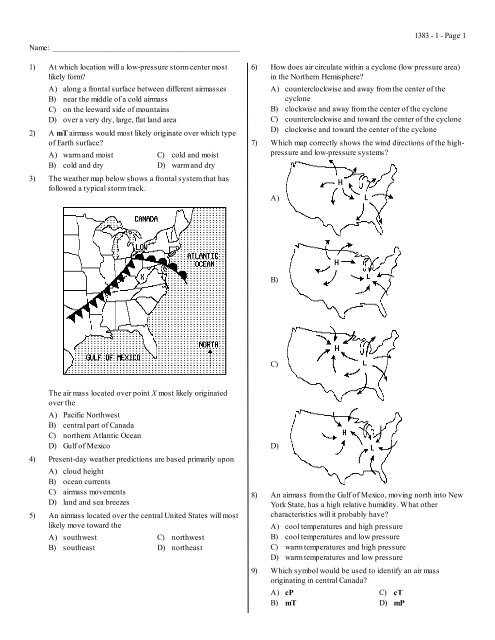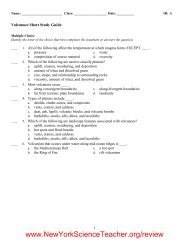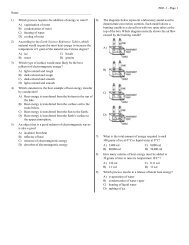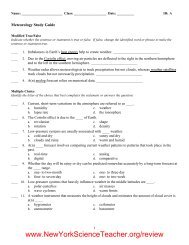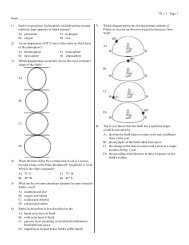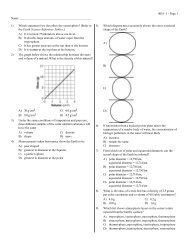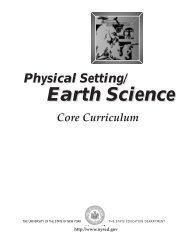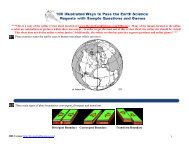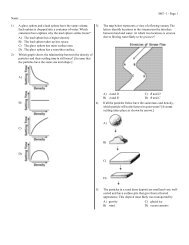Name - Earth Science Regents Review
Name - Earth Science Regents Review
Name - Earth Science Regents Review
- No tags were found...
You also want an ePaper? Increase the reach of your titles
YUMPU automatically turns print PDFs into web optimized ePapers that Google loves.
<strong>Name</strong>: ____________________________________________1) At which location will a low-pressure storm center mostlikely form?A) along a frontal surface between different airmassesB) near the middle of a cold airmassC) on the leeward side of mountainsD) over a very dry, large, flat land area2) A mT airmass would most likely originate over which typeof <strong>Earth</strong> surface?A) warm and moistB) cold and dryC) cold and moistD) warm and dry3) The weather map below shows a frontal system that hasfollowed a typical storm track.6) How does air circulate within a cyclone (low pressure area)in the Northern Hemisphere?A) counterclockwise and away from the center of thecycloneB) clockwise and away from the center of the cycloneC) counterclockwise and toward the center of the cycloneD) clockwise and toward the center of the cyclone7) Which map correctly shows the wind directions of the highpressureand low-pressure systems?A)1383 - 1 - Page 1B)C)The air mass located over point X most likely originatedover theA) Pacific NorthwestB) central part of CanadaC) northern Atlantic OceanD) Gulf of Mexico4) Present-day weather predictions are based primarily uponA) cloud heightB) ocean currentsC) airmass movementsD) land and sea breezes5) An airmass located over the central United States will mostlikely move toward theA) southwestB) southeastC) northwestD) northeastD)8) An airmass from the Gulf of Mexico, moving north into NewYork State, has a high relative humidity. What othercharacteristics will it probably have?A) cool temperatures and high pressureB) cool temperatures and low pressureC) warm temperatures and high pressureD) warm temperatures and low pressure9) Which symbol would be used to identify an air massoriginating in central Canada?A) cPB) mTC) cTD) mP
10) Which diagram below best represents the air circulationaround a Nothern Hemisphere low-pressure center?A)B)14) Why do clouds usually form at the leading edge of a coldairmass?A) Cold air contains more water vapor than warm air does.B) Cold air contains more dust than warm air does.C) Cold air flows under warm air, causing the warm air torise and cool.D) Cold air flows over warm air, causing the warm air todescend and cool.15) An air mass originating over north central Canada wouldmost likely beA) cold and dryB) warm and dry1383 - 1 - Page 2C) cold and moistD) warm and moist16) Which diagram correctly represents the air circulation in aNorthern Hemisphere high pressure airmass?A)C)C)B)D)D)17) A weather station records a barometric pressure of1013.2 millibars. Which diagram below would best representthis weather station on a weather map?11) On a weather map, an airmass that is very warm and drywould be labeledA) mTB) cTC) cPD) mP12) Cites A, B, C, and D on the weather map below are affectedby a low pressure system (cyclone).A)B)C)D)Which city would have the most unstable atmosphericconditions and the greatest chance of precipitation?A) D B) C C) B D) A13) A high-pressure center is generally characterized byA) cool, wet weatherB) cool, dry weatherC) warm, dry weatherD) warm, wet weather
18) The diagram below shows four points on a map with theirrelative positions to a low-pressure weather system. Whichpoint is most likely having heavy precipitation?1383 - 1 - Page 319) The diagram below represents a cross-sectional view ofairmasses associated with a low-pressure system. The coldfrontal interface is moving faster than the warm frontalinterface. What usually happens to the warm air that isbetween the two frontal surfaces?A) 1 B) 2 C) 3 D) 4A) The warm air is forced under both frontal interfaces.B) The warm air is forced under the cold frontal interfacebut over the warm frontal interface.C) The warm air is forced under the cold frontal interfacebut under the warm frontal interface.D) The warm air is forced over both frontal interfaces.20) An airmass originating over the North Pacific Ocean wouldmost likely beA) continental polarB) maritime polarC) maritime tropicalD) continental tropical21) Compared to a maritime tropical airmass, a maritime polarairmass hasA) lower temperature and less water vaporB) higher temperature and less water vaporC) lower temperature and more water vaporD) higher temperature and more water vapor
Questions 22 through 24 refer to the following:1383 - 1 - Page 4The diagram below represents a surface weather map of a portion of the United States. The map shows a low-pressure system withfrontal lines and five weather stations A through E. Note that part of the weather data is missing from each station. [All temperaturesare in DF.] [Refer to the <strong>Earth</strong> <strong>Science</strong> Reference Tables.]22) The wind direction at station A isA) southeastB) northeastC) southwestD) northwest23) The weather at station C would most likely beA) overcast, humid, and coolB) partly cloudy and warmC) very dry and extremely hotD) partly cloudy, windy, and very cold24) Assuming that the low-pressure system follows a normalstorm track, which weather station is probably located in thepath of the approaching center of the low?A) C B) A C) B D) E
Questions 25 through 29 refer to the following:1383 - 1 - Page 5The diagram below represents a weather map showing part of the United States. Letters A through E represent weather stations.25) At which weather station is precipitation most likelyoccurring at the present time?A) D B) B C) A D) E26) Which weather station model best represents weatherconditions at station B?A)B)C)D)27) Which station's weather has been influenced most recentlyby the passage of a cold front?A) B B) D C) C D) E28) At which weather station is the barometric pressure readingmost likely to be 1,018.0 millibars?A) D B) A C) C D) B29) If the low-pressure center follows a normal storm track, itwill move toward theA) southeastB) southwestC) northeastD) northwest
Questions 30 and 31 refer to the following:1383 - 1 - Page 6The map below represents a weather system located over the central United States. Letters A, B, C, D, and E locate weather stations onthe map.30) If the weather system follows a normal storm track at aspeed of 50 kilometers per hour, which best describes theatmospheric changes which will most likely occur at weatherstation C in about six hours?A) little atmospheric change with a low probability ofprecipitationB) air temperature increase, air pressure increase, andclearing skyC) air temperature decrease, air pressure increase, andprecipitationD) air temperature increase, no change in air pressure, andclearing sky31) Which weather station is experiencing clouds, heavyprecipitation, and rapidly decreasing air temperature?A) C B) D C) A D) B
Questions 32 through 34 refer to the following:1383 - 1 - Page 7The diagram below represents a section of a weather map for locations in the central United States. The letters A through I identifyreporting weather stations.
32) Which diagram best shows the fronts and their locations onthe weather map?A)33) Which weather station is least likely to experienceprecipitation during the next six hours?A) A B) C C) G D) F34) If the weather system follows a typical storm track, it willmove toward theA) westB) northC) eastD) south1383 - 1 - Page 8B)C)D)Questions 35 and 36 refer to the following:The surface weather map below represents a high-pressure center located over the central United States. The air pressure field lines arein millibars and the letters represent the locations of weather stations.
35) If the high-pressure center follows the typical direction ofmovement of an air mass across the United States, it willprobably move toward theA) northwestB) northeastC) southeastD) southwest1383 - 1 - Page 936) In which diagram do the arrows best represent actualsurface wind directions in this Northern Hemisphere highpressurecenter?A)B)C)D)


